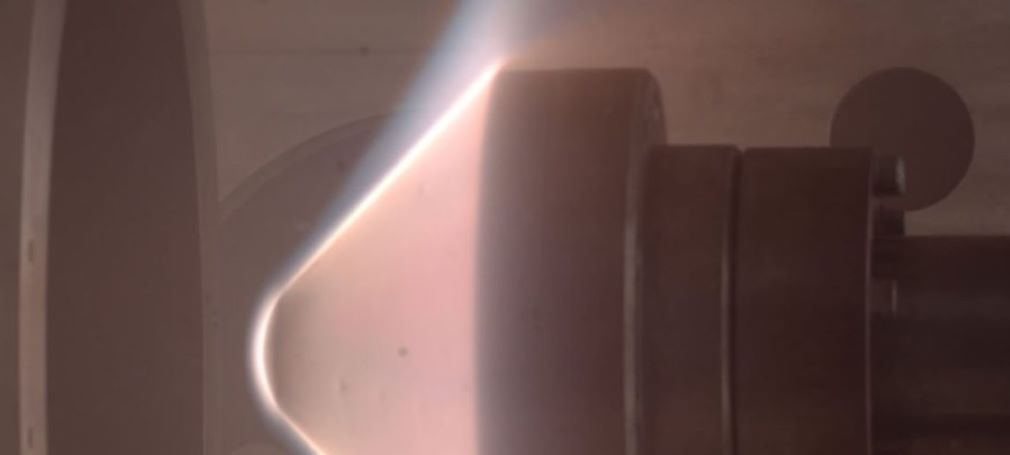Background
Hypersonic flows are characterized by complex thermochemical processes that are difficult to simulate. Ultimately, there is a need for experimental data to validate the multiple modeling approaches present in the literature. Optical emission spectroscopy (OES) can be used as a non-intrusive measurement to probe the excited thermo-chemical state of important radiating species,...
Background of the study
Optical emission spectroscopy (OES) is a valuable tool to gather information about complex thermochemical processes that take place in hypersonic flowfields. Furthermore, optical emission data plays a vital role in the validation of high-fidelity thermo-chemical models used to numerically simulate these flowfields. This work is part of an ongoing study at the...
- INTRODUCTION
Atmospheric entry leads to extreme heat flux onto the
flight vehicle’s surface due to the high enthalpy of the surrounding
flowfield. Currently, thermal protection systems
are severely oversized which makes vehicles too heavy,
restricting performance and payload capacity. One large
source of uncertainty is thermochemical non-equilibrium,
which has been shown to have a...
Abstract file attached
PDF Attached
Background of the study
Reflected shock tunnels are an excellent tool for studying high-temperature, hypersonic problems such as boundary layer transition, ablation, and shock-induced flow separation. These phenomena are known to be sensitive to the thermochemical state of the tunnel freestream. Although shock tunnels are a mature technology, much uncertainty in the tunnel freestream...
Background
The development of re-entry aerodynamic configurations requires examination of surface heat flux. Surface heating due to radiation at high-enthalpy stagnation conditions has been shown to comprise a significant portion of the total measured surface heat flux on re-entry configurations [1] [2]. Earlier studies in high-enthalpy flows on blunt sphere-cones [3] and capsules [4]...
Background of the study
An expansion tube is one of the ground-based experimental facilities that can generate a high-enthalpy hypersonic flow. A standard expansion tube consists of a compression tube, a shock tube, an acceleration tube, and a test section. In the expansion tube, the acceleration tube at extremely low pressure is connected to the shock tube with a thin diaphragm. The shock...
Background
The Electric Arc Shock Tube (EAST) at NASA Ames Research Center produces hypersonic shock waves for validation and improvement of non-equilibrium chemical kinetics and radiation models relevant to atmospheric entry flows. The main experimental technique employs four spectrometers, capable of achieving simultaneous spatially resolved emission spectra of the radiating gas from...
Background of the study:
This work demonstrates a versatile optical system capable of providing simultaneous radiation measurements from the vacuum ultraviolet (VUV) to the mid-wave infrared (MWIR). The system consists of several easily swapable configurations that aim to not only minimise experimental setup and alignment time but also increase the scientific output of the X2 expansion...
1 Background of the study
Mars has been the major focus of space exploration and interplanetary travel next only to
Earth. The current design process of thermal protection systems for Mars atmospheric
entry has large tolerances and uncertainities, which result an the excessive mass of heat
shield. One major contributing factor to the uncertainties is the lack of understanding of
backshell...
ESTHER is a two stage shock-tube. It comprises a \SI{1.6}{\metre} length and \SI{200}{\milli\metre} diameter combustion driver where He/\ce{H2}/\ce{O2} and \ce{N2}/\ce{H2}/\ce{O2} mixtures are injected by an automated gas filling system at initial pressures up to \SI{100}{\bar}. These mixtures are ignited through a Nd:Yag laser shooting on the back plate through a thick sapphire window,...
QUALIFICATION OF THE NASA AMES EAST LOW DENSITY SHOCK TUBE
Brett A. Cruden(1)
(1)AMA Inc, NASA Ames Research Center, Moffett Field, CA 94035, USA, E-mail:Brett.A.Cruden@nasa.gov
The Electric Arc Shock Tube Facility (EAST) at NASA Ames Research Center is a well established shock tube facility for quantifying shock layer radiation phenomena. First operated in 1965, EAST...
- INTRODUCTION
The complexity of the flowfield encountered around reentering
vehicles poses significant problems to the design
of spacecraft thermal protection systems. One
large source of uncertainty is linked to thermochemical
non-equilibrium. Ground testing is conducted to generate
flows similar to those encountered in flight, replicating
the essential features of non-equilibrium...
See attached

